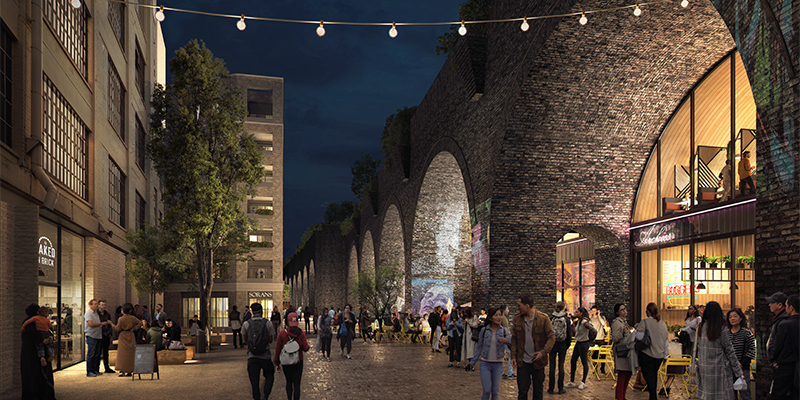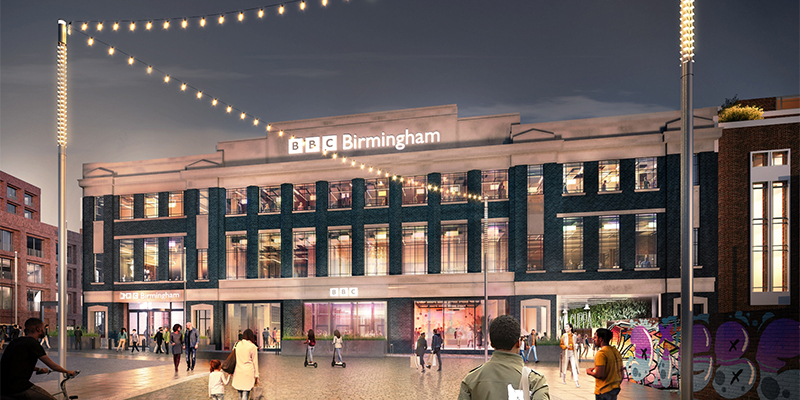Comment
Digbeth: The power of meanwhile uses for creating lasting regeneration
From shipping container shopping to industrial unit nightclubs and sporting-spectacular sites, ‘meanwhile uses’ provide a diverse and flexible space for innovative industries and events to grow. In the first of a series of comments exploring the creative and cultural powerhouse that is Digbeth in Birmingham city centre, including our work across the district, we take a closer look at the powerful impact such uses have in the quarter’s long-term regeneration.
The concept of ‘meanwhile uses’ looks to describe the utilisation of often vacant or under-utilised land for a diverse plethora of temporary purposes, from hospitality venues to cultural institutes, retail to commercial, exhibition to event spaces. While the temporary use of space within our cities is by no means new, the phenomenon of ‘meanwhile uses’ has grown rapidly within recent years in major cities internationally and here in the UK, as an impact of re-urbanisation, a relaxation of planning use classes and the growing cultural, economic and technological complexity of our urban environments.
These uses allow for the temporary re-activation and revitalisation of potentially unloved and vacant units and even urban quarters, breathing new life into a site and area, while the potential for longer-term regeneration comes forward. They allow a space to innovate and test ideas in commerce, culture and development, before more significant investment, infrastructure and connectivity is available.
Digbeth in Birmingham’s city centre provides the natural home for such uses. The distinctive and varied urban quarter, to the immediate south-east of Birmingham’s historic core, is characterised by its heritage as both the medieval birthplace of the city and the place at the centre of its industrial heartland. Once home to the production of Bird’s custard and Typhoo tea, amongst a thousand other industries within its streetscape of pitched and sawtooth workshops and factories, Digbeth is now witnessing a revitalisation following its industrial demise. Named the 'Coolest Neighbourhood in Britain' by the Sunday Times1 and described by Historic England as ‘cool, funky and beautiful, as well as dusty and noisy’2, it is now the name on everyone’s lips as the home of street food, street art, creative industries and alternative evening’s out. Its location, close to the proposed Birmingham Curzon Street terminus of HS2 and the forthcoming Midland Metro extension through towards Bordesley, makes it ripe for both long-term development and meanwhile uses while these works take place.
Gritty and imperfect, Digbeth’s underutilised assets are now being repurposed as new homes of the city’s creative and cultural boom. Floodgate Street, well photographed for its historic industrial character and catenary lighting, has become a hotspot of an emerging and growing hospitality sector, with new entertainment, drinking and competitive socialising venues popping up across the district. This includes 38 Floodgate Street, where planning has been secured for the change of use to a restaurant and event space, and 148 Adderley Street, where a new heavy-metal venue and themed bar will open in a disused industrial space. Our successful applications for the repurposing of these spaces will facilitate the expansion of the hospitality and leisure sector in Digbeth, well known for its original and independent entertainment, food and drink businesses.

It is of course now impossible to talk about Digbeth without reference to the creative sector. The £18 million investment in the ‘Creative Content Hub’ at The Bond, will house flexible workspace and event space for independent TV production and creative content developers in film, gaming and virtual production alongside the headquarters of the regional ‘Create Central’ industry group. At Bromley Street, we secured consent for Birmingham City University’s School of Acting, while at Rea Studios we successfully gained permission for BIMM Institute’s expansion in the City – part of major institutions now recognising the significance of Digbeth, its creative industries and clustering benefits. The former Typhoo Tea Factory, a grand 1930s art-deco factory, was used in the filming of Steven Spielburg’s ‘Ready Player One’, an example of meanwhile activities on site which has contributed significantly to the marketing of filming locations, and will now become the home of the BBC in Birmingham, hosting teams including BBC Three, The Archers, BBC Asian Network, BBC Newsbeat, BBC Radio WM and Midlands Today. Digbeth has incubated creative and media industries for years, and now with Steven Knight’s ‘Digbeth Loc’ film studios and other major investments on the horizon, is reaping the rewards. Reactivation uses across Digbeth, from nightlife to culture, have created a place where socially active and creatively minded people want to be, and in doing so breathe much-needed vibrancy and footfall throughout the day.

While ‘meanwhile uses’ are inherently temporary, some can be very short-term in their nature – but this does not necessarily reduce their impact. The hosting of the beach volleyball and 3x3 basketball at the Birmingham 2022 Commonwealth Games and the last two iterations of the Birmingham Pride festival have done more to cement the name ‘Smithfield’ in the city’s consciousness than years of masterplanning and public engagement. The site, directly adjacent to Digbeth, will become a new £2 billion mixed-use district for the city, and while the two events in question represent only ‘blinks of the eye’ in contrast to the permanence of the proposals, their scale, branding and media coverage have ensured the name ‘Smithfield’ is now recognised – the beginnings of ‘placemaking’ on a significant scale.
As such, ‘meanwhile uses’ provide much more than just a home for burgeoning industries and temporary installations. They bring informal vibrancy to underutilised spaces and cultivate a new neighbourhood which can then be brought forward into the regeneration of an urban quarter, such as Digbeth, as it formally develops.
In creating a place, creative ‘meanwhile’ use of space can be a fundamental part of the foundations of long-lasting and inclusive regeneration.
To find out more about our work in Digbeth, please get in touch with Ben Hood.
14 December 2022
[1] https://www.thetimes.co.uk/article/the-coolest-places-to-live-in-the-uk-from-birminghams-digbeth-to-manchesters-green-quarter-and-londons-new-east-end-vn0x7shw7
[2] https://historicengland.org.uk/whats-new/research/back-issues/uncovering-digbeths-heritage/
*Image courtesy of Glenn Howells Architects
Key contacts
You may also be interested in
News
6 September 2022
Turley supports Stoford’s appointment to spearhead BBC move to historic Typhoo Tea Factory in Birmingham
We are providing expert Planning, Heritage, EIA and Strategic Communications services to leading developer Stoford, who will spearhead the multi-million pound ...
News
2 December 2022
Turley submits plans for transformative redevelopment of Smallbrook Queensway Buildings
On behalf of CEG we have submitted a planning application to Birmingham City Council for its transformational plans for the redevelopment ...
News
1 April 2021
A Creative Content Hub is coming to Digbeth
Acting on behalf of Oval Real Estate, we have secured full planning permission for an £18m Creative Content Hub at The ...
